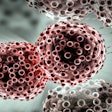
Deepcell on Monday announced the release of three data sets to enable researchers to explore novel high-dimensional morphology data.
The Menlo Park, CA-based firm said the data sets were generated using its high-throughput platform, comprising imaging and sorting instrumentation, artificial intelligence (AI) models, and a software suite.
It is releasing the data sets online and at the Advances in Genome Biology and Technology (AGBT) General Meeting, which is being held in Hollywood, FL, from February 6 through February 9.
“We’re releasing data to give researchers early access and get comfortable with multidimensional cell morphology, quantitative output as they think of their multi-omics experiments,” Giovanna Prout, vice president of marketing at Deepcell, said in an interview. “You can layer this new analyte onto transcriptomics or genomics in a pan-omics approach.”
High-content morphology data is usually generated by multiplexing many known markers or using complicated training regimens for interpretation with AI.
According to Deepcell, its platform is differentiated from other tools in the way that it provides output of high-dimensional cell morphology data at high throughput and resolution without a priori knowledge of cell markers.
“The platform consists of a benchtop instrument that does cell imaging and sorting without using such markers,” Prout said. “We believe that our AI model used for the data we're releasing is differentiated from any other such model used to analyze cell morphology or molecular data, and because this analyte has never been out there in the scientific world, we have developed a tool to visualize that type of data.”
The company said that its AI-based Human Foundation Model has been trained using millions of cell images, enabling scientists to produce high-dimensional readouts of known and novel morphology features from unlabeled cells in an unbounded hypothesis approach. The software suite also allows for the creation of custom cell classifications and identification of morphologically similar cell groups for sorting of viable cells to enable downstream molecular or functional analysis.
According to Deepcell, high-dimensional morphology can be used to inform discoveries across a broad variety of samples types such as cell lines, primary body fluids, and dissociated tissue samples, as well as across applications, including the characterization of complex samples, the creation of cell atlases, cell and gene therapy development, functional screening, cancer biology, and stem cell research, among others.
Kevin Jacobs, vice president of data science at Deepcell, said the approach is different from traditional approaches used to evaluate cell morphology.
“A pathologist who looks at a slide to examine cells generally obtains a qualitative score,” said Jacobs. “For example, the pathologist looking to stage and grade a prostate cancer biopsy might use a Gleason score. But the grading is limited by the training and ability of the pathologist, the ability to prepare the sample, and then a very subjective, highly specialized capability to infer from that data what that output should be. And that's a single outcome from evaluating the sample.”
By comparison, the Deepcell approach outputs “a very high dimensional set of measurements, similar to transcriptomics,” Jacobs said. “In this case, we are extracting relevant and important features from images that then can be analyzed using similar techniques to the analysis of transcriptomic or other high-dimensional data type that is common in the molecular space.”
The firm said its first data set released this week showcases how its platform can characterize different cell types in a heterogeneous sample in a label-free manner, and allows the user to analyze specific cellular populations of interest that are difficult to identify with molecular markers.
Specifically, three human cancer data sets are available for exploration. The Deepcell platform was used on a mixture of human melanoma cell lines and primary tumor samples to identify tumor, immune, and stromal cell populations in a label-free manner, using only morphology.
The melanoma tumor cell population data from this data set was then selected in the Deepcell software suite and re-projected using customized uniform manifold approximation and projection (UMAP) to gain additional resolution into the morphologically distinct subpopulation and to create a second data set.
The process reveals the heterogeneity within cells based on subtle morphological distinctions, including pigmentation which can be difficult to identify using conventional methods, Deepcell said.
In the final data set, its researchers use the label-free technology to explore the morphological diversity of immune cell populations in the lung tumor microenvironment from a variety of human dissociated tumor cell samples.
Overall, the release this week “is about putting this data out into the world, getting more eyeballs on it, and obtaining feedback,” Prout added.



















